For residents of Fair Lakes and beyond, the wait is over. Mike Harris, a website developer from Fair Lakes, perfectly encapsulates the sentiment of many local cyclists: “I’m very jealous of my friends that live in Arlington and Alexandria.” His envy stemmed from the well-established trail networks in those areas, networks that offered seamless connectivity and encouraged a car-free lifestyle. Like many, Harris yearned for the freedom to commute and explore by bike, seeking an alternative to the congested roads of Northern Virginia. His desire for accessible and safe cycling routes resonates deeply within the community, highlighting the need for infrastructure that supports alternative transportation.
Harris’s aspiration to cycle to his Tysons office led him to the Fairfax Alliance for Better Bicycling (FABB). While a volunteer mapped out a potential 13-mile route, the suggested streets and paths felt precarious. “I had to either decide to go on a sidewalk or be in the street, and I was very nervous about that,” he admitted. This common concern among cyclists underscores the critical importance of dedicated and safe bike trails, separated from vehicular traffic.
Then came the game-changer: the 66 Parallel Trail. “I was like, ‘This is the time. This is the time I can finally commute in to the office,’” Harris exclaimed. “It was finally a moment where I said, ‘I can do this.’” For Harris, and countless others, the I-66 Bike Trail entrance represents more than just a starting point; it’s an entry into a new era of cycling accessibility in Northern Virginia.
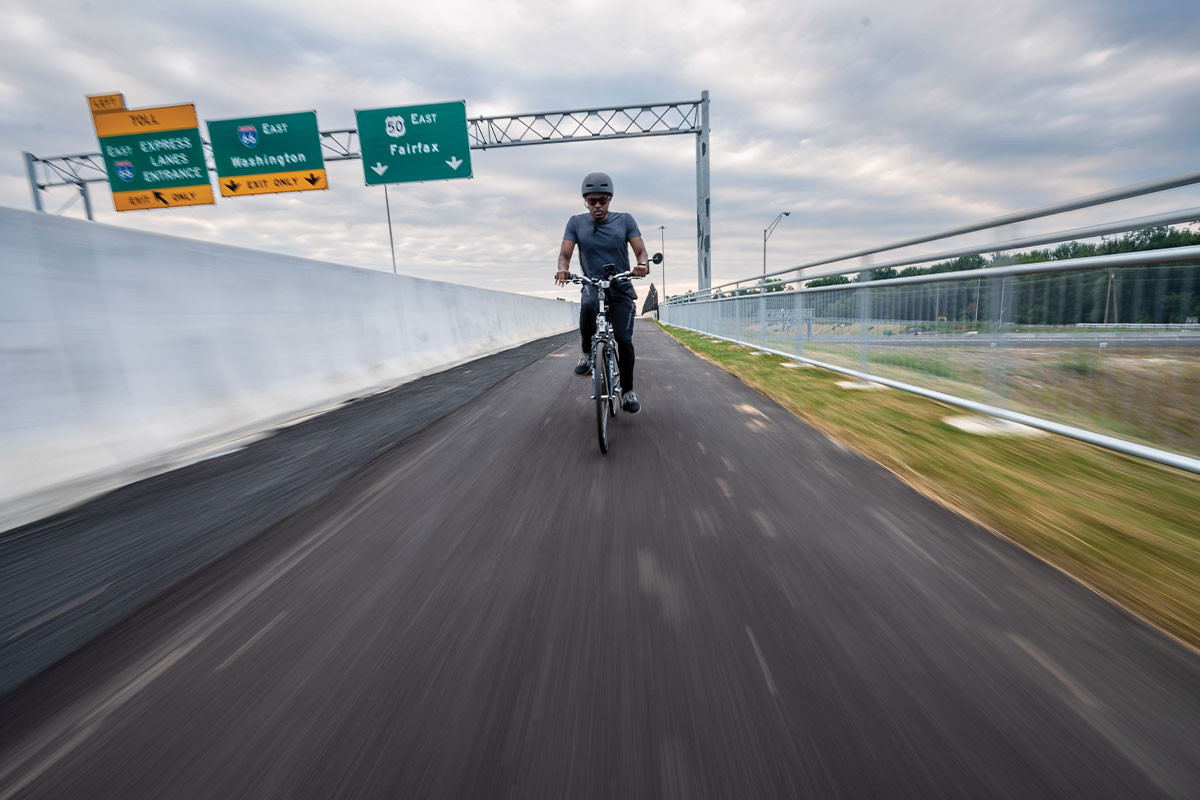 Person riding bike on trail next to I-66
Person riding bike on trail next to I-66
Unveiling the 66 Parallel Trail: Connectivity and Design
The 66 Parallel Trail is not just a trail; it’s an 18-mile artery of safe and engaging cycling infrastructure. Imagine a path that flows seamlessly – 18 miles of flat stretches, gentle slopes, playful curves, and even tunnel-like passages designed to navigate complex interchanges. Picture wide lanes spanning bridges and dedicated on-street bike lanes that integrate effortlessly with the existing urban landscape. The primary segment stretches for 11 miles, with an additional 7 miles weaving through interchanges and branching into neighboring communities. The design ethos prioritizes safety and accessibility, ensuring a welcoming experience for cyclists of all levels. However, the trail’s functionality doesn’t come at the cost of enjoyment. The innovative solutions to intricate design challenges have resulted in trail sections that are surprisingly fun and engaging to ride.
Currently, the trail extends from Gallows Road in Dunn Loring to Braddock Road in Centreville. While some sections were still undergoing final touches in early September, the Virginia Department of Transportation (VDOT) anticipated a full opening by early fall. Looking ahead, there are ambitious plans to extend the trail even further westward to Bull Run Regional Park in Prince William County. Transportation planners are optimistic that the 66 Parallel Trail will significantly encourage Northern Virginians to opt for cycling and walking, reducing reliance on cars for local trips and commutes.
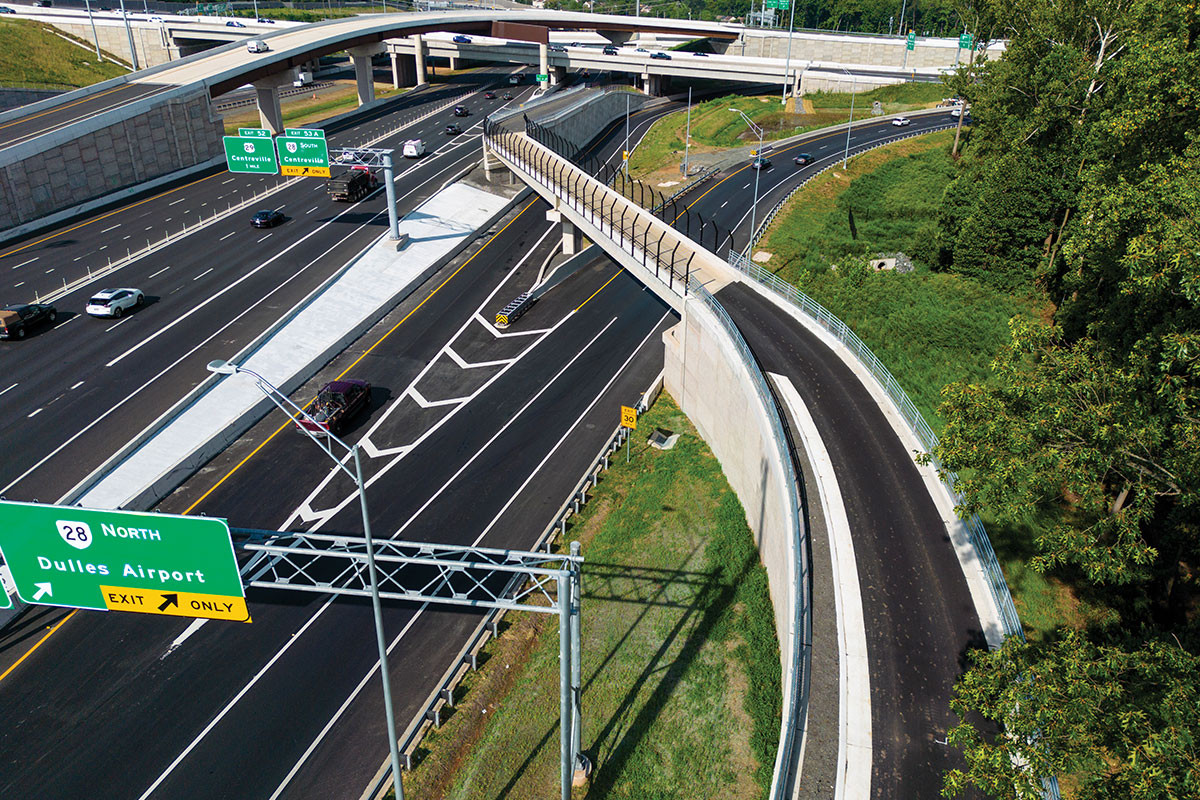 Bike trail goes over I-66 via bridge
Bike trail goes over I-66 via bridge
Lauren Delmare, program manager for the Active Transportation Program at the Fairfax County Department of Transportation, emphasizes the trail’s crucial role in enhancing east-west connectivity within the county. “It really does provide a lot of additional connectivity east-west through the heart of the county,” Delmare states. She highlights the trail’s strategic intersections with major existing trails: “We are connecting to the Fairfax County Parkway Trail, the Washington and Old Dominion Railroad Regional Park trail, and the Gerry Connolly Cross County Trail, which are three significant trails in the county.” These connections transform the 66 Parallel Trail into a central hub, linking together a broader network of cycling routes across the region.
Before the advent of the 66 Parallel Trail, Interstate 66 acted as a formidable barrier for pedestrians and cyclists. Delmare is particularly enthusiastic about the neighborhood-level connections the trail facilitates. “I’m excited about the little neighborhood connections,” she explains. “You can travel a quarter mile, half mile, a full mile down the trail and connect to another little spur to another community that previously you might have had to go significantly out of your way to get to.” These “little spurs” are key to unlocking the trail’s potential for everyday use, making it a practical option for errands, social visits, and local exploration.
Jeff Anderson, a member of FABB, echoes this sentiment after a ride near the Vienna Metro station. “It clearly is going to open up doors, not just to get people into the city or into Arlington or Vienna or Tysons, but just between the local places they want to go to,” Anderson observes. The trail’s value extends beyond just commuting; it provides a safe and enjoyable way to access local destinations and connect with nearby communities.
 Jeff Anderson from FABB on bicycle
Jeff Anderson from FABB on bicycle
Anderson points to the redesigned Nutley Street–Interstate 66 interchange as a prime example of the trail’s innovative design. “They’ve completely redesigned it for everyone’s use. It slows traffic down, allows cyclists to get through safely. I think it’s cool. Engineers must have loved designing this,” he remarks. His ride through tunnels and sweeping curves at the interchange left him impressed by the separation from traffic and the sheer enjoyment of the experience.
“The loopy interchanges are great,” Anderson adds. “The first impression by a rider will be, ‘Why? Why am I doing this?’ But at the same time, they’ll be doing it with a smile on their face. They’ll think it’s fun, and they’ll realize afterwards, ‘I never had to interact with an automobile.’ It’s safe and fun at the same time.” This blend of safety and enjoyable design is a hallmark of the 66 Parallel Trail, setting it apart as a valuable addition to the region’s cycling infrastructure.
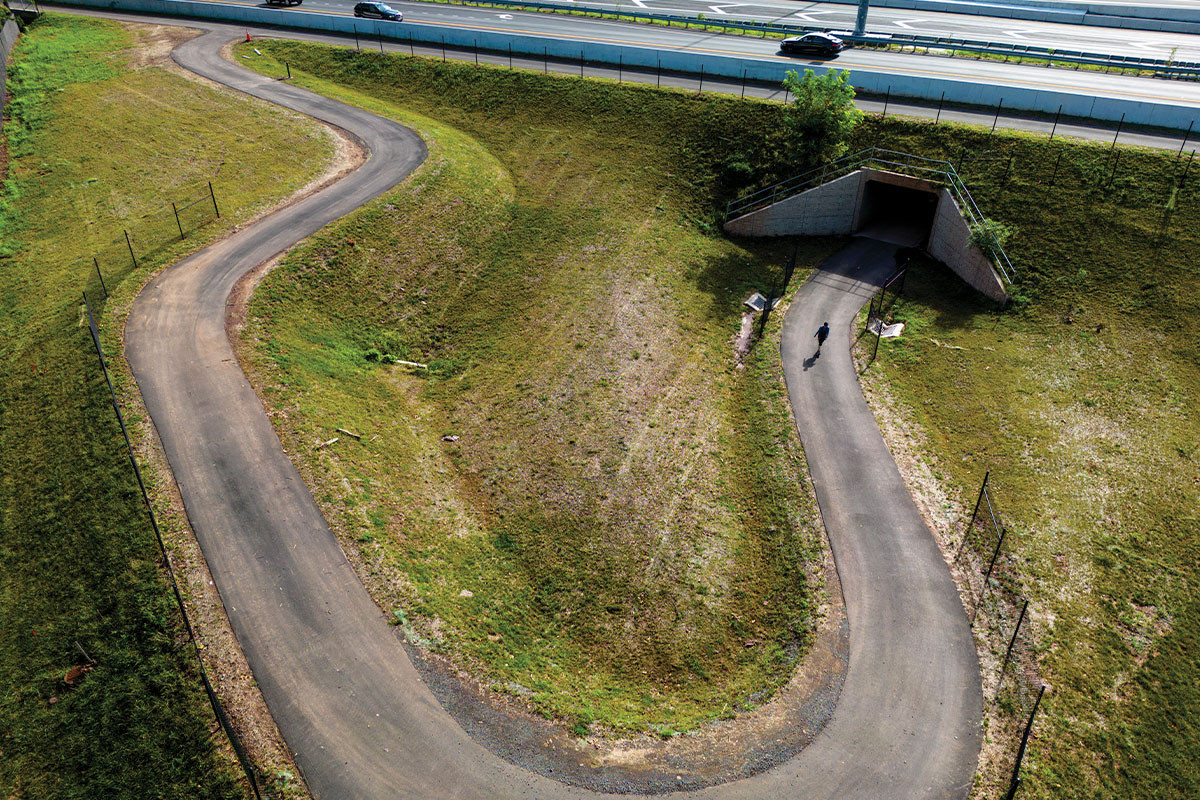 Loopy bike trail near I-66
Loopy bike trail near I-66
Balancing Practicality and Expectations on the I-66 Trail
The design of the 66 Parallel Trail was shaped by a multitude of factors: budget limitations, safety priorities, spatial constraints, public feedback, and accessibility mandates. Susan Shaw, megaprojects director and design-build program manager for VDOT, explains that these considerations led to a trail that is “plain, functional, flexible,” often situated between sound walls and the interstate. While designers incorporated elevated sections to create some buffer between cyclists and the roadway, substantial portions remain at road level. This proximity to the interstate means that trail users may experience significant road noise and potentially encounter exhaust fumes.
“The road noise is insane,” admits Mike Harris, despite his overall enthusiasm for the trail. Nevertheless, he recognizes the transformative potential of the trail in changing perceptions about transportation. “We should be able to empower our people to bike, walk, whatever they can do to get to work versus having to use traffic and tolls to get to the office,” Harris argues. “That’s the beauty of being empowered to just get on the road and not have to be reliant on a vehicle just to get around.” The 66 Parallel Trail, even with its limitations, offers a crucial step towards transportation flexibility and promoting active commuting options.
Transportation flexibility is indeed the core objective of the Parallel Trail, reflecting the evolving mission of the agency behind it. “We are the Department of Transportation, not the Department of Highways,” Shaw emphasizes, referencing the department’s name change in 1986. “Multimodal is very much a part of our culture and policy.” This shift in focus towards diverse modes of transportation is embodied in projects like the 66 Parallel Trail, which actively promotes cycling and pedestrian movement alongside highway infrastructure.
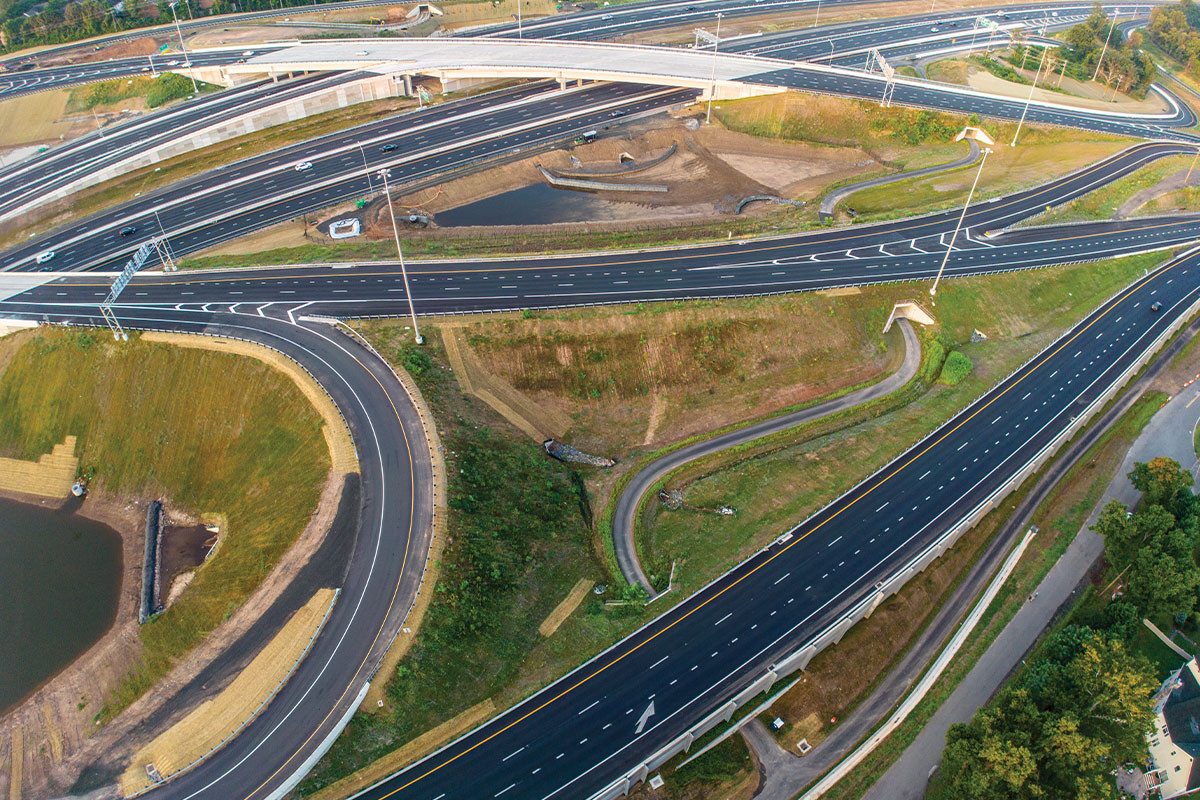 Aerial view of I-66 trail
Aerial view of I-66 trail
Pedaling into the Future: Opportunities and Exploration on the 66 Trail
The opening of the 66 Parallel Trail marks a significant milestone in Fairfax County’s long-term vision for a car-optional transportation network. The concept of a trail alongside Interstate 66 has been in planning since the 1970s, demonstrating a decades-long commitment to enhancing cycling infrastructure in the region.
Bruce Wright, president of FABB and a Reston resident, points out the broad impact of the trail. “A significant portion of the people that live in Fairfax County are relatively close to I-66,” Wright notes. He believes the trail will encourage a shift in mindset for those accustomed to car-dependent travel. “We want to broaden their perspective,” Wright explains. “We have a philosophy that everybody who wants to in the county should be able to make short trips by bike and walk, so that people who are close to a trail are able to go to the store, to be able to go to Metro, to be able to just take their normal trips where they don’t have to carry large objects.” The trail’s accessibility and connectivity make it a viable option for everyday errands and commutes, not just recreational rides.
While high usage is anticipated in the long run, the initial phase of the trail’s opening presents an opportunity for exploration and discovery. For many, the first encounters with the 66 Parallel Trail will be about experiencing a new route and appreciating its unique design.
Mike Harris’s early explorations of the trail, tracing his future commute route, exemplify this spirit of discovery. “The sweeping paths and the culverts were absolutely really cool,” Harris recalls. “It definitely changes the pace of it and makes it just a lot of fun.” The trail invites cyclists to explore its winding paths and appreciate the novel perspective it offers on familiar landscapes.
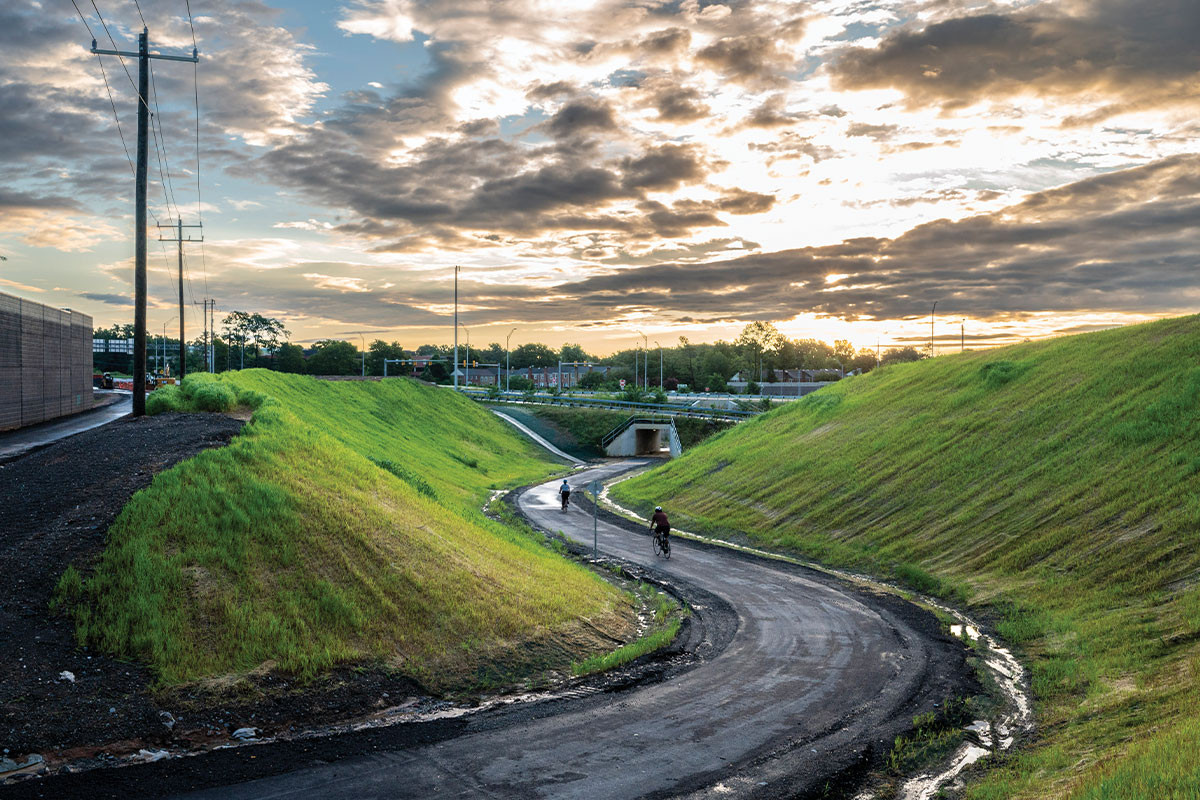 Cyclists on 66 Parallel Trail
Cyclists on 66 Parallel Trail
Katie Schaub and Christian Contreras, a couple from Reston, experienced this firsthand during their first ride on a sunny August morning. Parking in a nearby neighborhood, they easily accessed the trail and explored the area around the Route 123–Interstate 66 interchange. “I was impressed with the access of just coming off of the neighborhood and immediately there was the access trail there,” Schaub remarks. “The little intersections and intertwines are actually really cool.” The ease of access from residential areas is a key feature of the trail’s design.
Christian Contreras, a civil engineer, appreciates the broader urban planning implications of the project. “As a civil engineer, I’m always a big proponent for pedestrian movement and how to mediate or remedy urban sprawl,” Contreras states. “And I think [the trail] accomplishes that, especially making it a lot safer for pedestrians to be near the highway and around it.” The 66 Parallel Trail serves as a model for integrating pedestrian and cycling infrastructure into complex urban environments.
The presence of the 66 Parallel Trail is already influencing future trail development in Fairfax County. Lauren Delmare notes that it has become a catalyst for prioritizing complementary trail projects. Many of these will be smaller-scale improvements, such as enhanced crosswalks or short trail links. “The 66 Parallel Trail is such a big, big regional connector,” Delmare concludes. “There is a real connection versus just a line on the plan of what we want to do in the future. Now it’s here, and now it’s even more important to bring people to it.” The I-66 bike trail entrance is not just the beginning of a trail, but the starting point for a more connected and bike-friendly future in Northern Virginia.
Project Background: Transform 66 and the Parallel Trail
The 66 Parallel Trail is a component of the larger Transform 66 Outside the Beltway Project in Northern Virginia, a massive undertaking to revamp the I-66 corridor. This comprehensive project includes the addition of Express Lanes, bridge replacements, interchange redesigns, expanded park-and-ride facilities, and improved bus services.
The easternmost section of the Parallel Trail stretches from the Dunn Loring Metro Station westward to U.S. 50, incorporating both dedicated trail segments and streetside paths. At the U.S. 50 interchange, the trail diverges from I-66, continuing west along streetside paths (both new and existing) for over two miles before intersecting the Fairfax County Parkway north of the interstate. From Fairfax County Parkway, the trail proceeds west to Braddock Road, where U.S. 28 intersects with Interstate 66.
The construction of the trail was financially supported by I-66 Express Mobility Partners, a private partnership, and carried out by FAM Construction, a joint venture of Ferrovial Construction and Allan Myers.
Feature image by Will Schermerhorn
This story originally appeared in the October issue of Northern Virginia Magazine. For more articles like this, subscribe to Northern Virginia Magazine.
